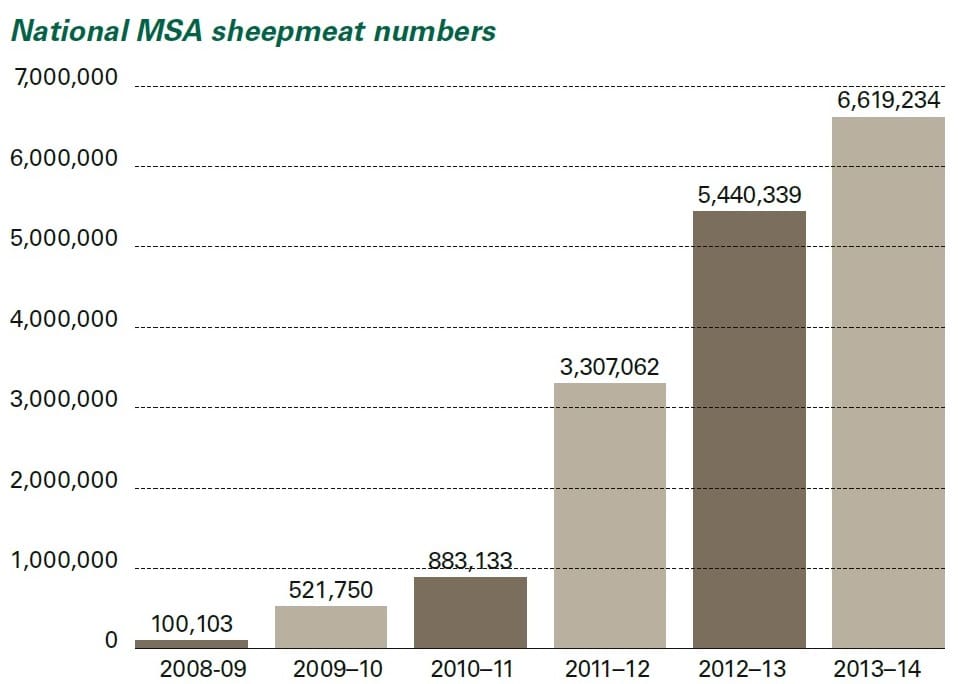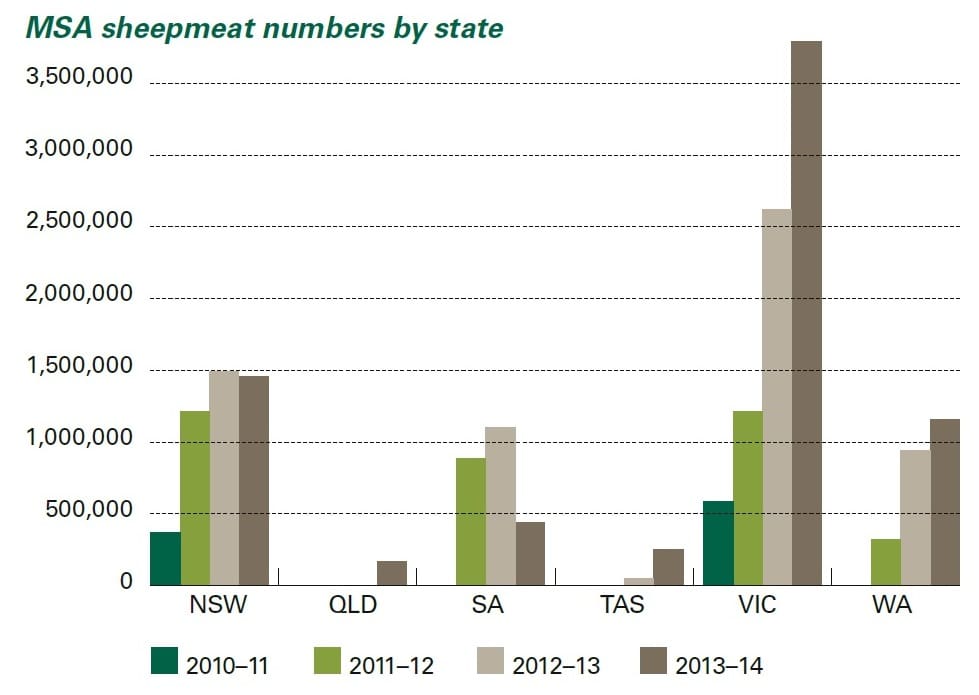MOMENTUM in the growth of the Meat Standards Australia sheepmeat program shows no signs of slowing down, with more than six million lambs being graded under the program for the first time in 2013-14.
Financial year data released by Meat & Livestock Australia shows an increase of more than one million head, or 22 percent over the previous financial year.
While grading activity in NSW and Sough Australia declined last year, there was explosive growth evident in Victoria, where numbers graded climbed to about 3.75 million. Western Australia and Tasmania also grew solidly, and Queensland registered on the database as an MSA sheepmeat-producing state for the first time.
MLA attributes growth primarily to the adoption of MSA pathways by major processors and retailers, along with the development of commercial lamb brands underpinned by MSA by processors and brand managers.
Three additional abattoirs became licensed to process MSA sheepmeat in 2013-14, including the first MSA-licensed sheepmeat processor in Queensland.
Processing of MSA sheepmeat now occurs through 18 MSA licensed processors in all states, with 42pc of the lambs presented for MSA in 2013-14, being trademarked through the supply chain.
Tasmania and Victoria experienced the greatest growth in the volume of MSA lambs processed against MSA standards compared to 2012-13:
- Victoria lifted MSA lamb grading throughput by more than one million head, to reach about 3.75 million head
- NSW recorded a marginal check in numbers, to just below 1.5 million head.
- South Australia’s decline was marked, falling from about 1.1 million head the year before to 450,000 head last financial year, due to seasonal conditions and other factors
- Western Australia logged solid growth, up about 350,000 head to 1.3 million lambs
- Tasmania grew from very small numbers the year before to reach about 250,000 head last year.
Compliance rate Australia-wide against MSA and company specifications was 93.5 percent.
Growth in participating producers
Of the 7193 new MSA livestock producer registrations processed in 2012-13, 63pc have become accredited to supply MSA sheep. There are now currently 37,616 MSA registered livestock suppliers across Australia.
Brands continue to expand
A strong feature of the MSA program is its ability to underpin quality systems behind Australian lamb brands. During 2013-14, there was a significant increase in the number of MSA-licensed lamb and beef brands compared with 2012-13. These brands became licensed to use the MSA trademark to support their own brand, adopting MSA grading to ensure consistent quality of their products.
There are now 108 licensed MSA lamb and beef brands in Australia.
420 new end-users
As of June 30, 2014, there was a 4pc increase in MSA licensed red meat wholesalers, with a total of 345 businesses supplying 2414 MSA licensed retail and food service outlets with MSA lamb and beef, Australia-wide.
These outlets include independent butchers, supermarkets and foodservice operators. During 2013-14, 420 new end-user outlets joined the program, licensed to promote and sell MSA beef and sheepmeat with the MSA trademark. Woolworths only adopted MSA at retail level during 2012, meaning that ‘pull-through’ effect from the nation’s largest retailer is only now being fully-reflected in full-year lamb grading results.
This year’s MSA grading growth has been complemented by an increase in consumer awareness of MSA.
MLA last year launched a renewed push to re-engage with consumers and food service operators over awareness and appreciation of the MSA program.
In 2013-14 that consumer awareness work focussed on a digital campaign in an effort to further build awareness and extend understanding of the MSA symbol and system. The campaign delivered more than five million online impressions, and more than 200,000 consumers have viewed YouTube clips.
Following this campaign, consumer awareness of the MSA symbol at the end of 2013-14 increased to 55pc, with 80pc of these consumers indicating they saw the MSA symbol as trustworthy.
Research and development activities concerning sheepmeat eating quality during 2013-14 have focused on genomic predictions for intramuscular fat, shear force and lean meat yield as well as establishing the foundations of an enhanced cuts-based grading system for lamb supported by objective carcase measurement technologies, including those for measuring GR fat.




HAVE YOUR SAY